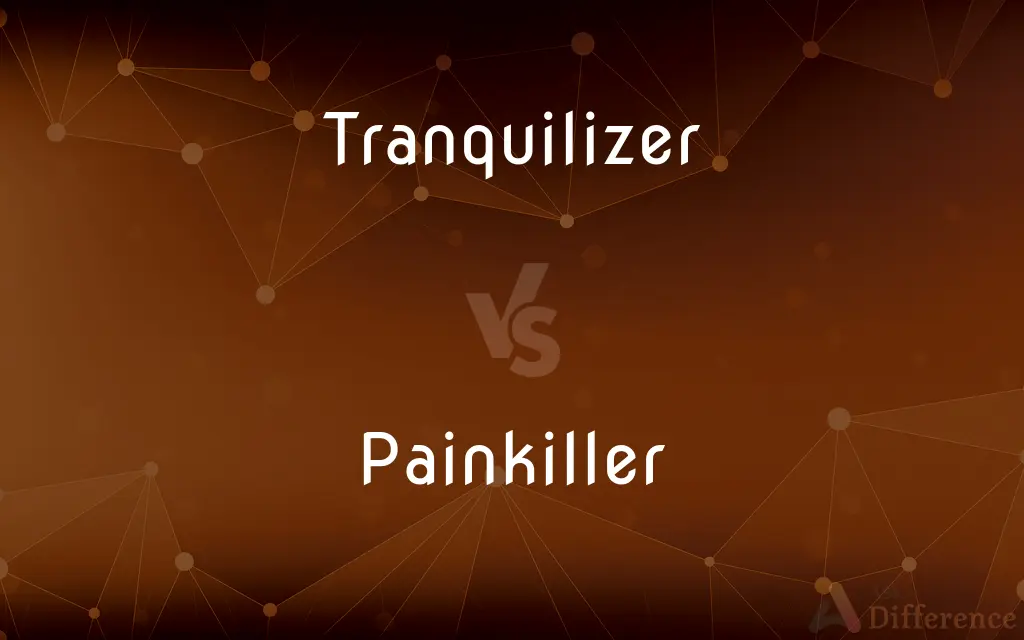Tranquilizer vs. Painkiller — What's the Difference?
By Tayyaba Rehman & Urooj Arif — Updated on March 15, 2024
Tranquilizers are primarily used to calm and reduce anxiety without necessarily relieving pain, while painkillers are medications specifically designed to relieve pain.

Difference Between Tranquilizer and Painkiller
Table of Contents
ADVERTISEMENT
Key Differences
Tranquilizers are medications that have a calming effect on the central nervous system, often prescribed to reduce anxiety and tension. They work by affecting neurotransmitters to induce relaxation and reduce anxiety symptoms. Examples include benzodiazepines and certain antidepressants. On the other hand, painkillers, also known as analgesics, are a class of drugs specifically aimed at alleviating pain. They can range from over-the-counter options like acetaminophen and ibuprofen to prescription narcotics like morphine and oxycodone, targeting different pain pathways in the body.
While tranquilizers are used to manage psychological conditions by inducing a state of calm or sleepiness, painkillers are focused on physical symptoms, directly addressing pain regardless of its source. This distinction is crucial in medical treatments, as the choice between a tranquilizer and a painkiller depends on the underlying condition being treated.
The side effects and risks associated with tranquilizers and painkillers also differ significantly. Tranquilizers, especially when used long-term, can lead to dependency and withdrawal symptoms. Painkillers, particularly opioids, carry a high risk of addiction and other serious side effects, including respiratory depression and gastrointestinal issues.
In terms of administration, both tranquilizers and painkillers can be taken orally, but other forms such as intravenous injections, patches, or rectal suppositories might be used depending on the specific medication and clinical scenario. This flexibility allows healthcare providers to tailor treatments to individual patient needs.
It's also worth noting that while some medications primarily serve as either tranquilizers or painkillers, certain drugs can have overlapping effects. For example, some anticonvulsants and antidepressants can offer pain relief in specific conditions while also having calming properties.
ADVERTISEMENT
Comparison Chart
Primary Use
To calm and reduce anxiety
To relieve pain
Examples
Benzodiazepines, antidepressants
Acetaminophen, ibuprofen, morphine, oxycodone
Target
Central nervous system, neurotransmitters
Pain pathways in the body
Common Side Effects
Dependency, withdrawal symptoms
Addiction, respiratory depression, GI issues
Administration Forms
Oral, intravenous, patches, suppositories
Oral, intravenous, patches, suppositories, rectal
Compare with Definitions
Tranquilizer
Medication that reduces anxiety.
Lorazepam is a widely used anxiolytic tranquilizer.
Painkiller
A drug that relieves pain without causing unconsciousness.
Paracetamol is a commonly used analgesic painkiller.
Tranquilizer
A drug that induces calmness and often drowsiness.
Many tranquilizers have sedative effects to help patients relax.
Painkiller
A class of drugs that includes natural, synthetic, and semi-synthetic opiates.
Morphine, an opioid, is used for severe pain management.
Tranquilizer
Some antidepressants have tranquilizing effects, reducing anxiety.
SSRIs can function as mild tranquilizers in anxiety disorders.
Painkiller
Non-steroidal anti-inflammatory drugs that relieve pain and reduce inflammation.
Ibuprofen is an NSAID used for pain relief.
Tranquilizer
Drugs used to treat psychosis, also having a tranquilizing effect.
Haloperidol is a neuroleptic that can act as a tranquilizer.
Painkiller
Drugs that cause temporary loss of sensation in a specific area.
Lidocaine is a local anesthetic used as a painkiller during minor surgeries.
Tranquilizer
A substance that induces sleep, a common effect of stronger tranquilizers.
Certain tranquilizers are prescribed as hypnotics for insomnia.
Painkiller
Medications that reduce fever and can have analgesic properties.
Aspirin is used both as an antipyretic and a painkiller.
Tranquilizer
Any of various drugs used to treat psychotic states; an antipsychotic drug. Not in scientific use.
Painkiller
A medicine used in to relieve pain.
Tranquilizer
A tranquilizer refers to a drug which is designed for the treatment of anxiety, fear, tension, agitation, and disturbances of the mind, specifically to reduce states of anxiety and tension.Tranquilizer, as a term, was first used by F.F. Yonkman (1953), from the conclusions of investigative studies using the drug reserpine, which showed the drug had a calming effect on all animals it was administered to. Reserpine is a centrally acting Rauwolfia alkaloid.
Painkiller
A medicine used to relieve pain
Tranquilizer
Any of various drugs used to reduce tension or anxiety; an antianxiety agent.
Painkiller
An agent, such as an analgesic drug, that relieves pain.
Tranquilizer
One that serves to tranquilize, as soothing music.
Painkiller
(pharmaceutical drug) A drug that numbs the pain in the body.
Tranquilizer
(pharmaceutical drug) A drug used to reduce anxiety or tension.
Tranquilizer
A drug used to reduce stress or tension without reducing mental clarity
Tranquilizer
That which tranquillizes or soothes.
Tranquilizer
One who, or that which, tranquilizes.
Common Curiosities
Are there risks associated with using tranquilizers?
Yes, tranquilizers can lead to dependency and withdrawal symptoms, especially with long-term use.
How do painkillers relieve pain?
Painkillers block the transmission of pain signals to the brain or reduce the brain's perception of pain.
Can a medication be both a tranquilizer and a painkiller?
Some medications may have overlapping effects, but they are generally classified based on their primary use.
Can tranquilizers be used for pain relief?
While tranquilizers primarily target anxiety and tension, some may indirectly relieve pain associated with muscle spasms or tension-related conditions, but they are not typically used as primary pain management medications.
Can over-the-counter painkillers be harmful?
While generally safe when used as directed, over-the-counter painkillers can cause adverse effects, such as liver damage from acetaminophen or gastrointestinal issues from NSAIDs, if taken in high doses or for a prolonged period.
What are tranquilizers used for?
Tranquilizers are used to reduce anxiety, induce calmness, and sometimes treat insomnia or psychosis.
Can painkillers be used to treat anxiety?
Painkillers are not typically used to treat anxiety since their primary function is to relieve pain, not alter mood or anxiety levels.
How long does it take for a painkiller to start working?
The onset of action for painkillers varies; some, like ibuprofen, may begin working within 30 minutes, while others, especially some prescription painkillers, may take longer to take effect.
What is the difference between an opioid and a non-opioid painkiller?
Opioids are a class of drugs that include substances derived from opium as well as synthetic analogs, primarily used for severe pain, whereas non-opioid painkillers, such as NSAIDs and acetaminophen, are used for mild to moderate pain and do not act on opioid receptors.
Are tranquilizers addictive?
Some tranquilizers, particularly benzodiazepines, can be addictive and may lead to physical dependence and withdrawal symptoms if used long-term or abused.
Are there any non-medication treatments for pain management?
Non-medication treatments for pain management can include physical therapy, acupuncture, massage, biofeedback, and cognitive-behavioral therapy, which can be effective especially for chronic pain conditions.
What are the signs of painkiller overdose?
Signs of painkiller overdose can include severe drowsiness, confusion, constricted pupils, nausea, vomiting, and in severe cases, respiratory depression and loss of consciousness.
What are natural alternatives to tranquilizers?
Natural alternatives to tranquilizers include herbal remedies like valerian root, chamomile, and lavender, as well as practices such as meditation, yoga, and mindfulness, which can help reduce anxiety and promote relaxation.
Can I build a tolerance to painkillers or tranquilizers?
Yes, with regular use, individuals can build a tolerance to both painkillers and tranquilizers, requiring higher doses to achieve the same effect, which can increase the risk of side effects and dependence.
Share Your Discovery

Previous Comparison
Humility vs. Simplicity
Next Comparison
Supervisee vs. SupervisorAuthor Spotlight
Written by
Tayyaba RehmanTayyaba Rehman is a distinguished writer, currently serving as a primary contributor to askdifference.com. As a researcher in semantics and etymology, Tayyaba's passion for the complexity of languages and their distinctions has found a perfect home on the platform. Tayyaba delves into the intricacies of language, distinguishing between commonly confused words and phrases, thereby providing clarity for readers worldwide.
Co-written by
Urooj ArifUrooj is a skilled content writer at Ask Difference, known for her exceptional ability to simplify complex topics into engaging and informative content. With a passion for research and a flair for clear, concise writing, she consistently delivers articles that resonate with our diverse audience.















































